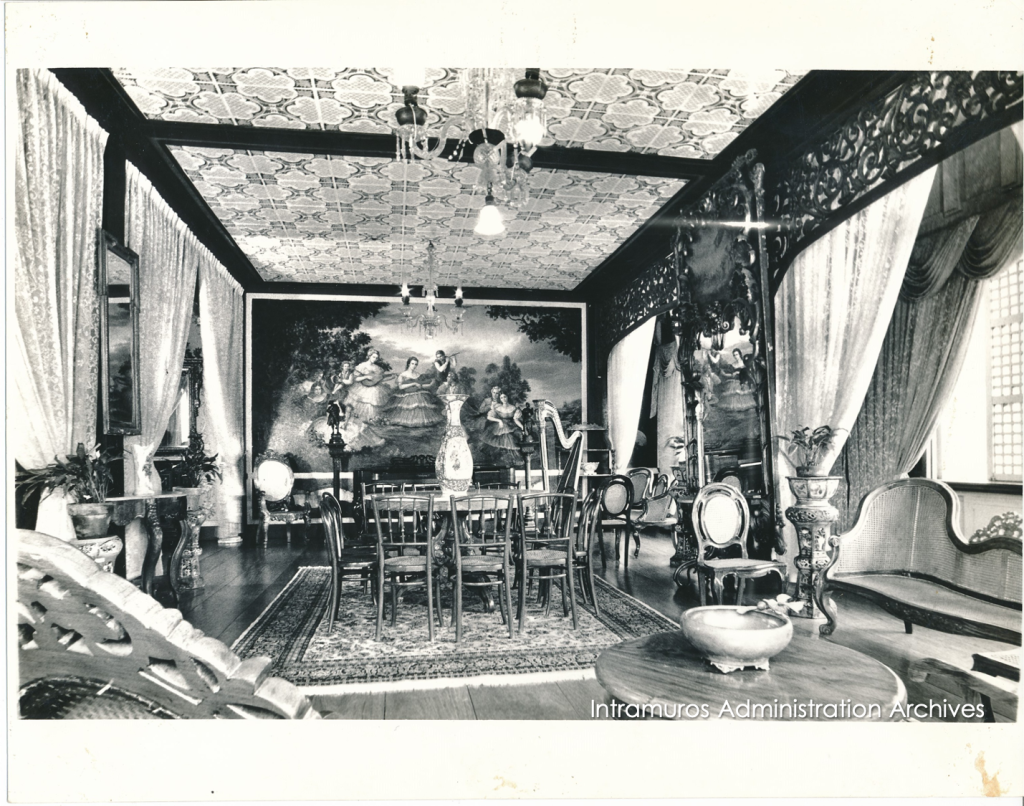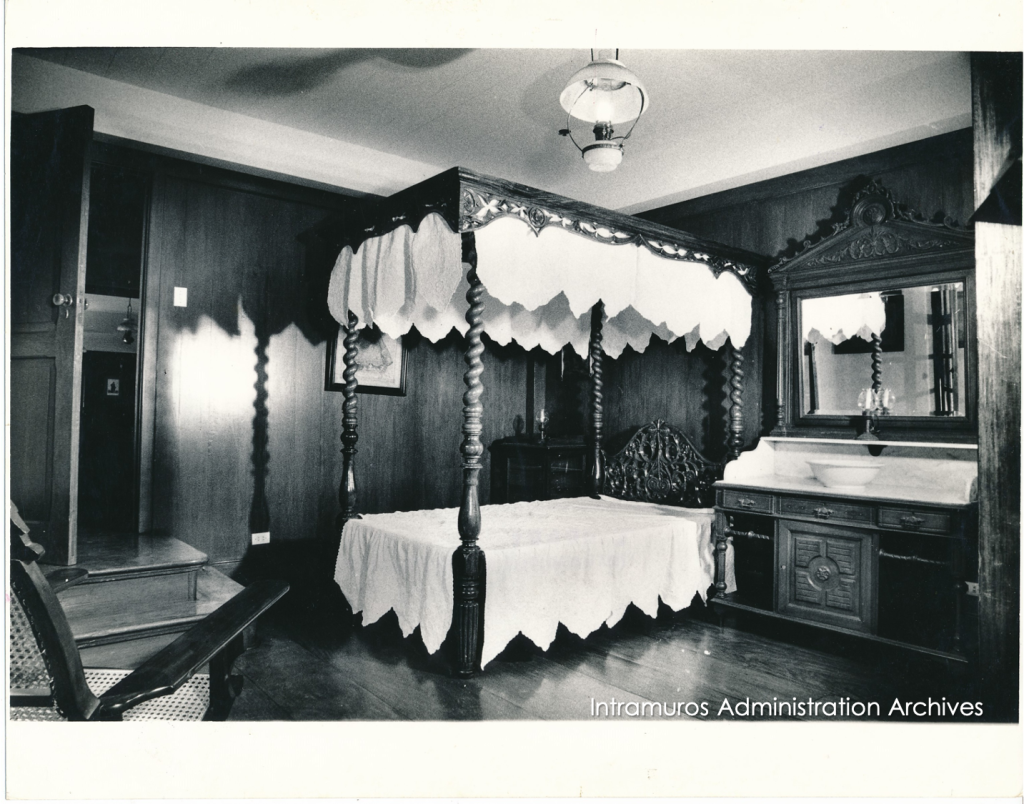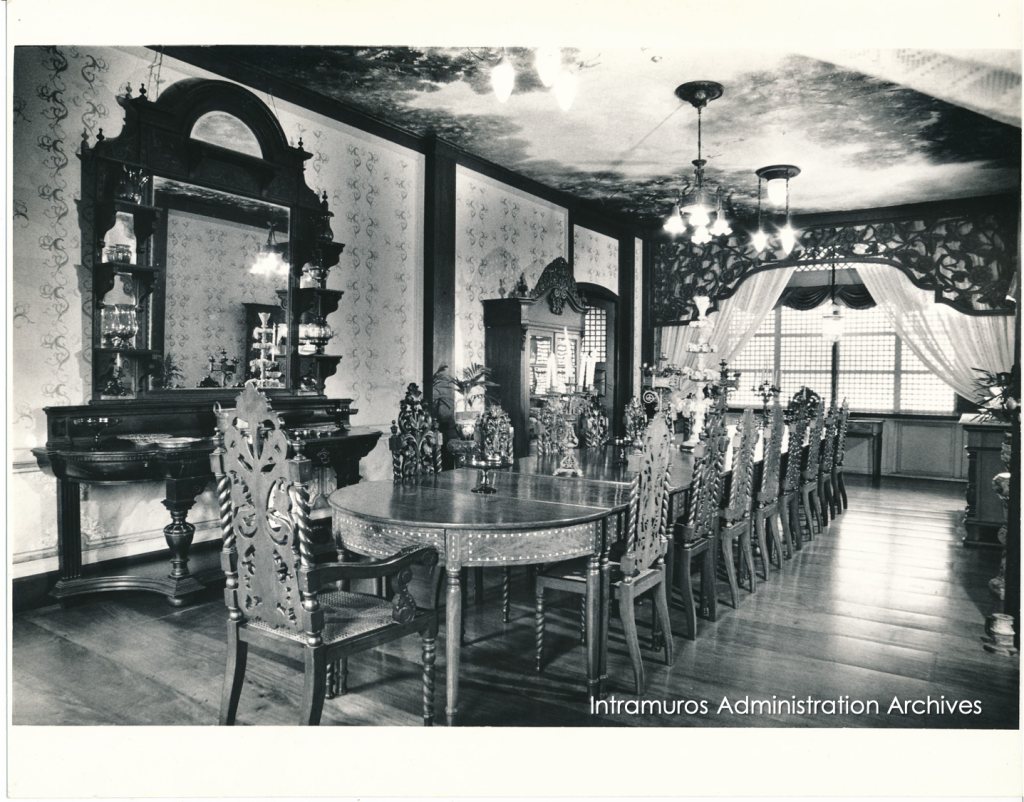The Ghosts of Casa Manila
By Martin I. Tinio Jr.
Note: This article was originally published in 1990 (Gaceta de Intramuros Vol. III No. 3 1990).

Caption: Sala of Casa Manila, 1984. Photo from the Intramuros Administration Archives
Casa Manila is one of the houses in Plaza Luis, IA’s cultural-commercial complex just opposite San Agustin Church. Its facade is modelled after a 19th century residence in Calle de Jaboneros in Binondo. Constructed from 1981 to 1983, Casa Manila consists of a life-style museum, specialty shops, function rooms and the IA Museum Division office.
They say that ghosts live in Casa Manila. Laborers, staffers, tenants and guests claim they have encountered these blithe spirits at one instance or another, even in broad daylight, during and after construction.

Caption: Casa Manila under construction, 1980. Photo from the Intramuros Administration Archives
This is not surprising as the archaeological excavations in the site yielded a well-covered with a mass of masonry. Inside the well were numerous skeletons. The bones could belong to people who had hidden and were trapped in the wells during World War II, or they could have been dead bodies dumped by American forces to save them the trouble of digging graves. Many believe that the dead continue to haunt the place because they were not given Christian burial.
During the construction of Casa Manila, the guards and laborers related hearing footsteps going up the stairway of the azotea (roof garden) late at night. After that they would sense an invisible body falling from the azotea and landing on the granite pavement — like someone committing suicide.
When the elevator was being installed, the man working on it noticed that everytime he put down his tools, they would be in different place when he was about to pick them up. After this had occurred several times, he refused to come back unless he had a companion to hand him his tools.
The utility rooms at the basement were not spared. The maintenance workers often saw a man’s shadow in the air-conditioning control room, but everytime they went to check who it was, the shadow disappeared. Once, they felt that someone invisible in the electrical room was playing with the circuit breaker because the lights were going on and off by themselves.
The first time Casa Manila was thoroughly cleaned after its construction, the janitors cleaning the museum’s “Old Maid’s Room” heard hands clapping from the adjacent “Bachelor’s Room” which was empty. They thought the spirit must have been happy about the place being cleaned, at last.

Caption: Old Maid’s Room, 1984. Photo from the Intramuros Administration Archives
While leading some foreign guests during a cocktail party, several guides noticed that the latrina or washroom (under which a modern toilet fixture had been installed) flushed everytime the door was opened. This happened about four times that evening and several times after. The engineers said it was impossible for the device to flush by itself. Could it have been a ghost enjoying the novelty of a 20th century toilet?
One bright morning , a lone janitor was busy mopping the floor of the museum’s “Dining Room” on the third floor. When he stopped to pick up his broom, he saw a bearded European-looking mas wearing a frock coat and top hat swiftly pass behind him. He had heard no footsteps. suddenly , he realized he had seen a ghost and ran. His supervisor later found him shaking in a corner of the janitor’s lounge.

Caption: Dining Room, 1984. Photo from the Intramuros Administration Archives.
The museum shop off the patio has also been scene of eerie events. A janitor assigned to clean the bathroom was surprised to see the area in darkness and vainly tried to turn on the light several times. Suddenly, the fluorescent lamp fell and broke into myriad pieces. He left hurriedly to report the incident but when he came back, he saw the bathroom lit by the fluorescent lamp and not a trace of the broken lamp.
A few days after, an IA employee saw the door of the bathroom shake repeatedly as if someone wanted to get out. Then the door opened by itself. All the exterior doors of the shop were closed; no gust of wind could have done it. This experience, however, was nowhere as frightening as that which occurred the following week to the same employee.
She had the habit of taking a nap in the museum shop during noon breaks. After locking the door she would rest her feet on an antique table.
One day, she was awakened by someone clutching her thigh. When she opened her eyes, a European-looking man with a high-bridged nose, deep-set eyes and long beard, wearing a Prince Albert coat and top hat stood in front of her. She tried to scream but the nas had grabbed her throat. He then reproved her for putting her feet on the table which had been used in his wedding. The employee was all the more scared when she saw that the figure was cut off at the knees and floating on air.
Then gradually, the apparition rose toward a corner of the room and disappeared. Realizing that she had seen a ghost, she screamed and hastily left. Her description of the ghost tallied exactly with the one the janitor had seen in the dining room.
On another afternoon, a Spanish mestiza in her mid-fifties approached the same employee who was standing outside the shop. Thinking that the woman was a visitor who wanted to see the museum, the employee offered to accompany her inside. The old woman courteously declined, and she said she was just taking an afternoon stroll. The woman confided, however, that she had already gone around the place and even knew the owners of the furniture and where these had come from. She described a table that was used during a wedding, the music that was played, etc. the lady even said that she used to live in the area.
Finally realizing that she was talking to a ghost, the employee tremblingly lighted a cigarette to calm herself. After a few seconds, the lady disappeared. Terrified by her experiences and afraid of losing her sanity, this employee asked for a transfer.
At the basement workshop, a member of the conservation staff working on a santo (religious image) left it on a table. When she came back, the santo was gone. Diligent search found it in the bathroom. How it got there, nobody knows.
Also at the workshop, a British furniture restorer saw a glass jar full of acetone levitate and slowly move from one table to another.
One night, the lights in the patio repeatedly went on and off on their own accord. Then water started to flow from the fountain only to stop abruptly. As this happened past midnight when the whole complex was locked, the guards were afraid to investigate until daylight when the technician arrived. The technician could not explain the occurrence.
All these events prompted the museum staff to have the whole complex blessed by a priest. The manifestations lessened in number but have not altogether stopped.
One museum guest, a French instructor with strong psychic vibrations, felt the presence of a man in his early twenties following him. The spirit, which described as friendly, was a Spanish mestizo whose schooling was cut short by his unexpected death. Could this spirit be the same one heard intermittently knocking on the ceiling while some employees were decorating the teatrillo for an affair? Was it the one who produced the sound of raindrops on the ceiling even when it was sunny outside?
No one knows why the ghosts are still in Casa Manila. Could it be that the reconstruction was done so well that they feel at home and have decided to stay?
Editor’s Note: The writer, former IA Consultant for Research and Publications, is co-author of “Philippine Ancestral Houses.” He has also penned various articles on food and antiques.
For more information contact the Center for Intramuros Studies via research@intramuros.gov.ph
Cannot find what you are looking for? Try requesting for more data via our eFOI Portal.





